Try these simple present activities in your adult ESL classes!

My students always struggled more with the simple present than they did with the simple past or simple future. Using simple present activities was a fun way to review this concept to help them master it.
If you already have the basic simple present rules down pat, just scroll past this next part. You might like this next part if you are new to teaching and know how to use grammar without knowing the rules (and thus have difficulty explaining them to your students).
Quick Simple Present Review
When is the simple present tense used?
Understanding when to use the simple present is sometimes a bit confusing for students and can be mixed up with the present progressive. Simply put, we use the simple present to describe:
- habits
- unchanging situations
- general truths
- fixed arrangements (which often take place in the future!)
What are the three common completions for the simple present when the main verb is be?
- subject + be + noun
- subject + be + adjective
- subject + be + place/time
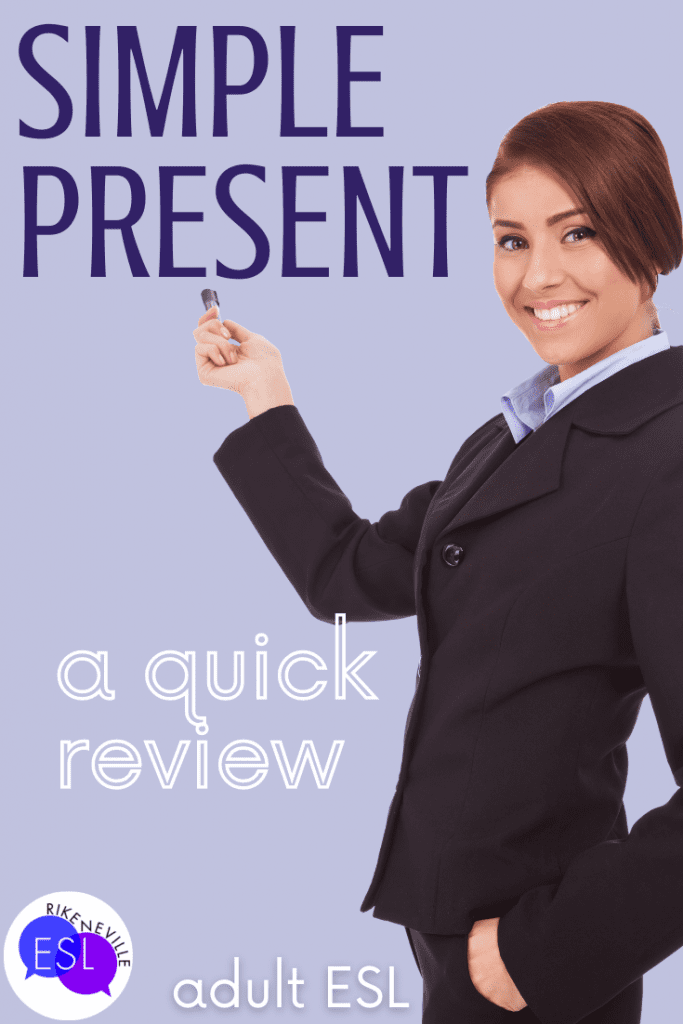
For example:
- This is a book. (noun)
- I am not hungry. (adjective)
- They are in the library. (place) The event is at ten o’clock. (time)
What are the spelling guidelines for simple present verbs?
- for most verbs, add -s to the end
- if the verb ends in a vowel + y, add -s.
- if the verb ends in consonant + -y, delete the -y and add -ies.
- if the verb ends in -sh, -ch, -x, -s, -z, add es
What are the pronunciation rules for the final -s in the third-person singular simple present?
- Base verbs ending in the SOUND of /ʃ/, /ʧ/, /s/, /z/ or /ʤ/ take a /ɪz/ or /əz/ sound (depending on region) which adds a syllable to the third-person singular verb..
- Base verbs ending in a voiceless sound have a /s/ sound at the end when in the third-person singular.
- Base verbs ending in a voiced sound take a /z/ sound when in the third-person singular.
A common complaint of adult ESL students in grammar classes is that they don’t get enough time to talk. Allowing them this time is a battle when you teach in an IEP (Intensive English Program), but making speaking a central part of simple present activities increases their understanding of the concept and their enjoyment of their class.
Okay, now let’s dive into the games and activities!
Simple Present Activities Your Adult ESL Students Will Love
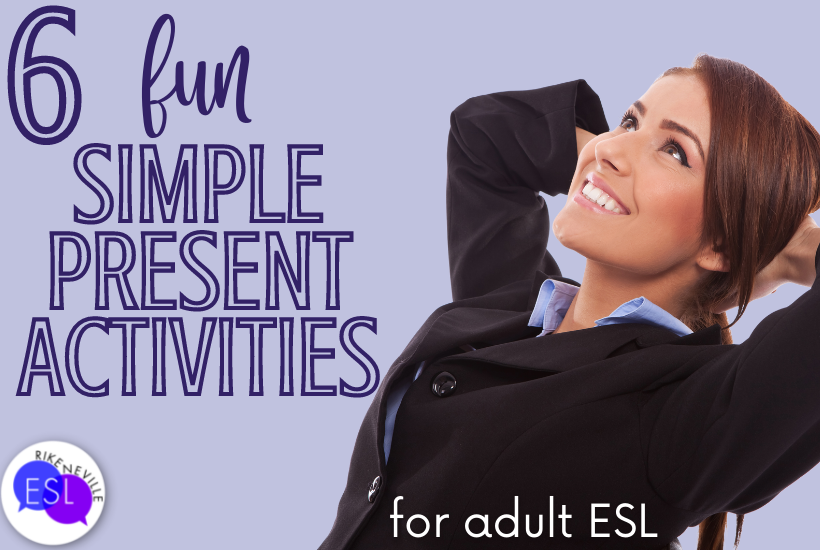
Simple Present Discussions
I love using discussions tied to just about any grammar concept. Here’s one to add to your repertoire for simple present activities.
First, write a list of topic starters on the board that suits the level of your class. For example, with a class of high-level speakers, your theme could be generations (Generation Z, Millennials, Generation X, Boomers, Silent Generation), and your topics starters could include: their annoying habits, best qualities, greatest skills, hardships, triumphs, etc.
Low-level classes would do better with a more accessible topic like animals. Instead of topic starters, use columns for verbs, adjectives, and nouns to help them get started. You could use verbs such as swim, climb, hunt, fly, and scratch along with adjectives like heavy, thin, furry, soft, and nouns such as legs, eyes, skin, teeth, etc.
Next, have your students write as many simple present statements as possible that they think everyone (or almost everyone) in their group will agree with. They can do this individually or in pairs. For example,
- This generation cares greatly for the environment.
- This animal has smooth skin and swims well.
Then, bring them together into pairs or groups. Students take turns reading their answers while their partner or group members try to guess what they are describing (which generation, animal, etc.).
The Worst Learning Habits / The Best Steps to Take to Achieve a Goal: Simple Present Activities
If you have a class of students not shy about sharing their opinions, of all the simple present activities shared here, this is the one for them! If your students repeatedly use the same phrases when sharing their views, take a look at my resource, Expressions for Opinions. You’ll want to keep a close eye on the time with this simple present speaking activity as students can be so engaged that they don’t want to stop! I suggest deciding how much time you have for it and then starting it that much before the end of class so that it doesn’t take over the entire class.
They’ll love the speaking component of this simple present activity. You’ll love how it leaves you some freedom to circulate, informally assess, take notes, and enjoy listening to them.
Whenever I had a class with students who were quickly discouraged or struggled a lot, I tried to stick with positive themes for my simple present activities, using the topic of “Successful Goal-Achievers.” However, when my students were more of a fun-loving lot, they were far more engaged with topics like “Habits of an Unsuccessful Student.” Whichever way you lean, here’s what you do.
- Write the topic of choice on the board.
- Tell students to write statements of fact/opinion for each topic. I usually assigned a minimum number with “or more” directly after the number. Give them an example or two to use the simple present in this activity. For example:
- They take small steps.
- They make plans.
- They don’t give up.
- She doesn’t get enough sleep.
- He doesn’t ask questions.
- She always uses the same study method.
- Bring students into groups of 4-6. Have them share their answers and discuss which answers they agree or disagree with and why.
Cultural Norms Bluff
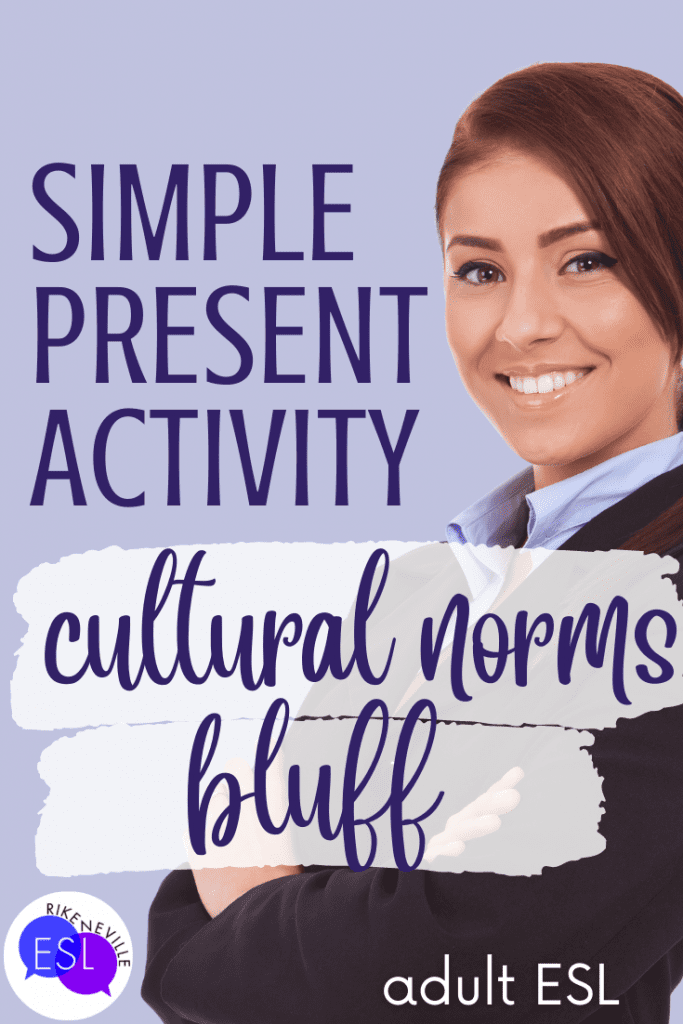
Frequency adverbs are often (tee-hee) used with the simple present, so they are an excellent addition to any simple present activities you might do with your adult ESL students. For classes with a good mix of cultures, try this true/false guessing activity!
Tell your students to write simple present statements about how things are (or are not) done in their culture and to include frequency adverbs. (always, usually, often, frequently, typically, never, rarely, seldom, etc.) Depending on their level, you may wish to write some possible topics on the board to help them get started. For example, food, gender roles, driving habits, and holidays.
Instruct them to include both true and false statements. Challenge them to write statements that are true but sound false and some that are false but sound true. The false statements could also have two cultures mixed up. For example, a student from Mexico could claim that Mexican people often eat using chopsticks. Or, the frequency adverbs could be incorrect. “Iranian people almost always eat with their left hands.”
After they’ve had some time to write their simple present statements, pair them up to be with someone of another culture (if possible). If there aren’t many different cultures represented, try doing groups of 3-4 with at least two different cultures. Have them share their statements, and their partner (or group members) must guess whether the statements are true or false.
Then, have students pair up with someone from another culture and share their sentences (and culture) with their partners.
Survey Summaries
I love this simple present activity because it helps students get to know each other or learn about students in another class. If your class is relatively new and your students don’t know each other well, have them survey each other. If they’ve already been together for a while, talk to another class teacher to set up a time for your class to visit theirs. Conversational visits are fun for the students of both classes!
First, as a class, come up with a list of simple present getting-to-know-you questions to ask. You’ll need a minimum of one question per student. Here are some examples:
- What do you do after class?
- Who do you like to spend time with?
- Do you enjoy sports?
- Does your family eat dinner together?
Then, assign each student at least one question. This is where you can differentiate by level or to account for personality differences (fewer questions for lower-level students or more questions for outgoing students, for example).
Either have students ask their classmates the questions (and record the answers), or take them to another class to ask those students.
Finally, have students take turns sharing what they learned.
- Min-Ji picks up her daughter from daycare after class.
- Omar cooks dinner for his family after class.
- Maria helps her kids with their homework after class.
You can have each share all their sentences at once or have them all share their sentence(s) about the same person before moving on to the next person.
Min-Ji picks up her daughter from daycare after class. She likes to spend time with her friends. She doesn’t enjoy sports. Her family usually eats dinner together.
Make Me!
There are two versions to this simple present activity. Whichever you choose, consider daring to offer yourself up as the person to be questioned! Students love getting to know their teacher, and they’ll have fun creating imaginative questions when they feel safe to do so, which they might not if they must ask a classmate.
Make me say, “Yes!”
Students ask the teacher or their partner as making questions as possible that begin with “Do you…? or Are you…?” For each “Yes, I do/am” response, they earn one point. For each “No, I don’t” or “No, I’m not” response, they either don’t get a point or lose a point! They will quickly realize that they can rack up the points if they ask questions such as, “Do you speak English?” and “Are you in class?”
Option: You can allow them to also ask about your (or their classmate’s) family and friends with “Does your…?” and “Is your…” to give them practice with the third person singular.
Make me say, “No!”
As you can guess, this is played basically the same as “Make me say, ‘Yes!’.” However, with this version, instead of asking super obvious (and possibly a bit boring) questions to win as many points as possible, students will quickly work out that they can create wacky questions. For example, “Do you eat soup with chopsticks?” or “Are you a famous pop star?” or even “Do you have a popular YouTube channel?”
How DARE You?!
Full disclosure: I swiped this from a worksheet in my Simple Present vs. Present Progressive resource, but it’s easily tweaked to focus only on the simple present.
I’m sure that you’ve had to field inappropriate questions from students that range from mildly inappropriate to wildly offensive. Guess what? So have your students! Think about how something perfectly innocuous in one culture could start a fight in another. Your students are wading through that daily, especially if they are lucky enough to have a good mix of cultures in their class. Use this to your advantage with one of my favorite simple present activities!
Have students create a list of simple present questions that they can ask without causing the slightest bit of offense and some that they think or know should NOT be asked. Here are a few examples you can use to help them get started:
- Do you think you are attractive?
- How old are you?
- Do you enjoy cooking?
- Are you tired?
- Do you ever pick your nose?
Pair them up or have them work in small groups of 2-3 to pool their questions.
Instruct them to rate the questions on a scale of 1-5 for how comfortable they would be in answering those questions. 1 = no problem 2 = easy 3 = a little difficult 4 = very difficult 5 = no way
Be sure to allow them time to discuss their ratings with each.
OPTION: Challenge them to ask each other questions. The person asking the question assigns a point value to the answer. Refusing to answer means no points earned. If they don’t want to answer, they should decline with a gentle refusal like “I’d rather not answer that.” or a strong refusal like “Mind your own business!”
Enjoy using these simple present activities!
Ready-Made Resources

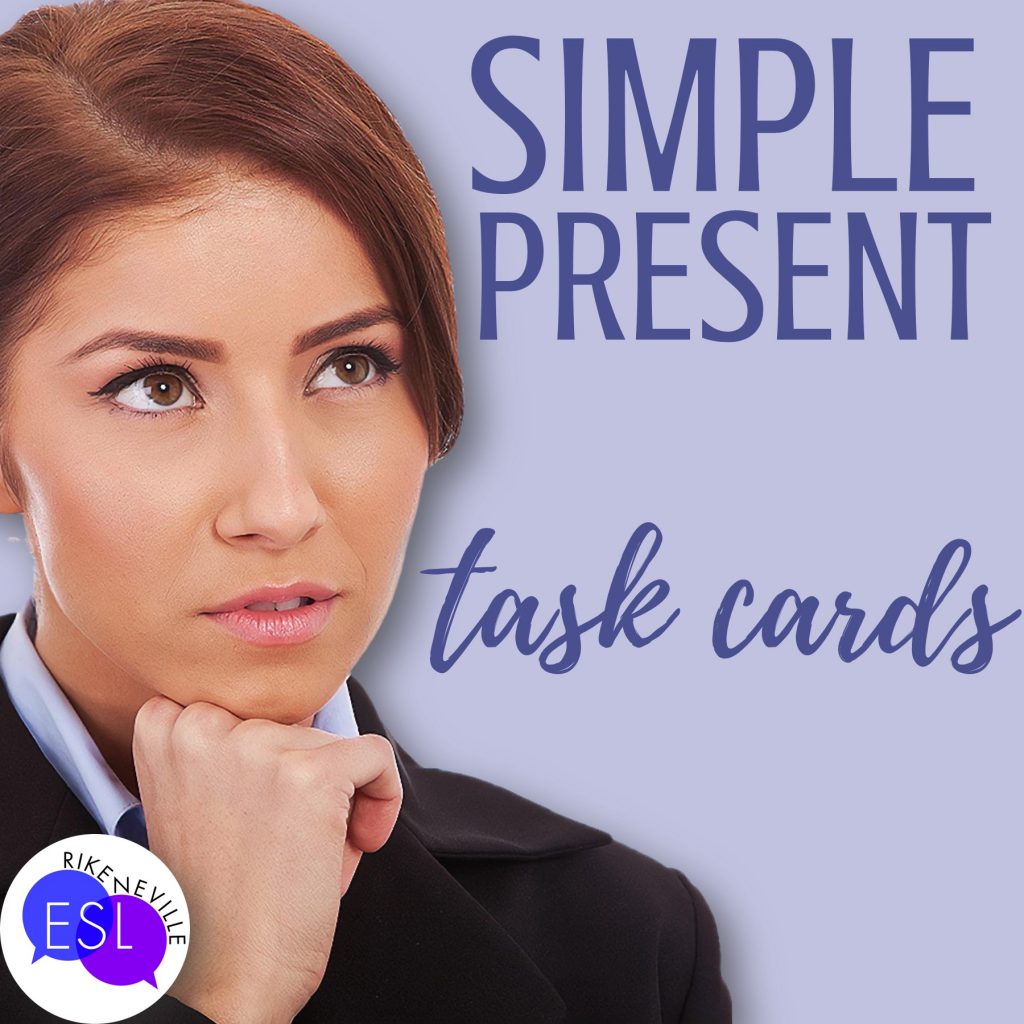
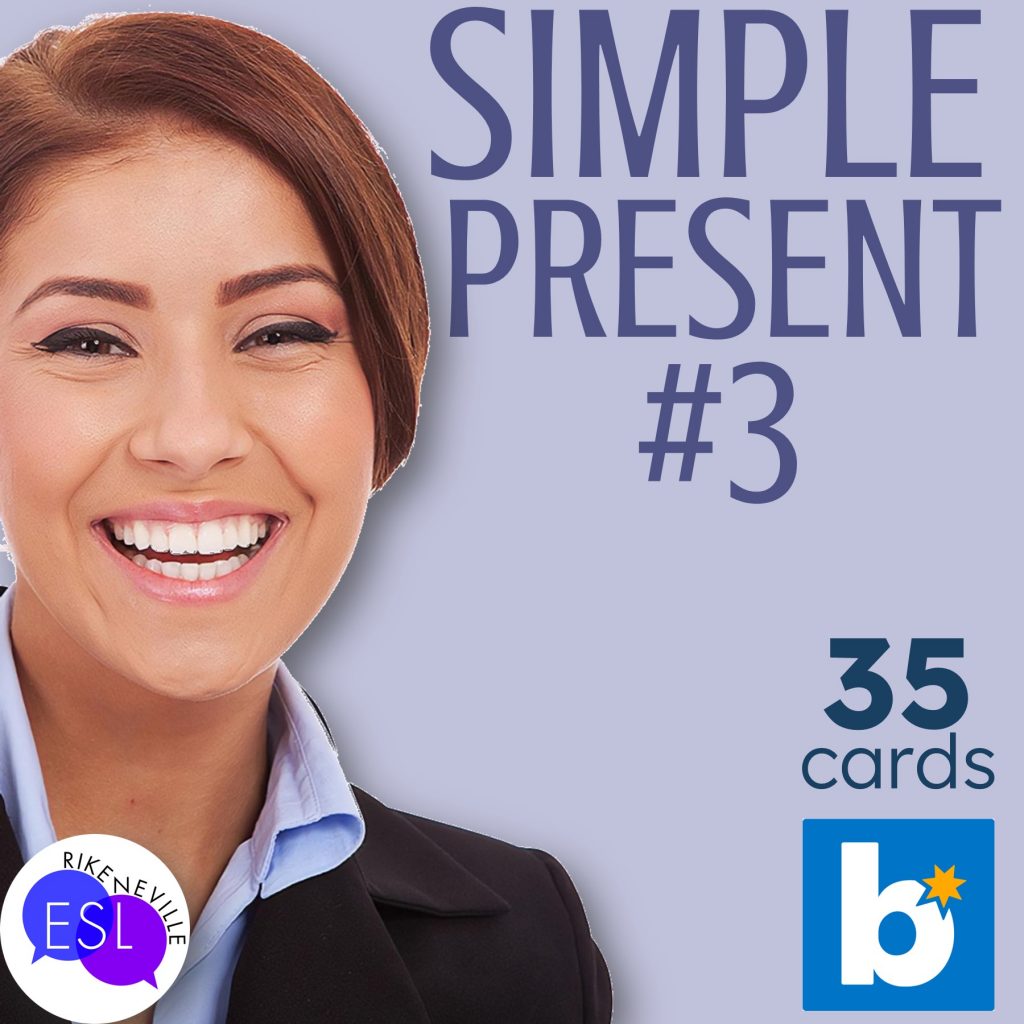
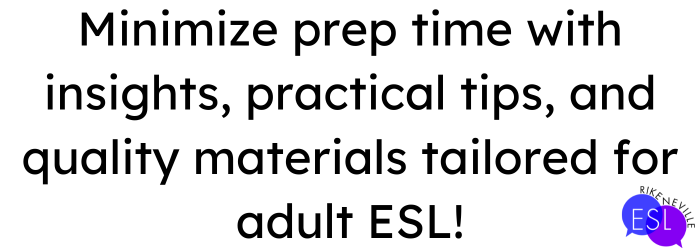
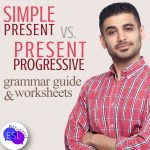
Leave a Reply